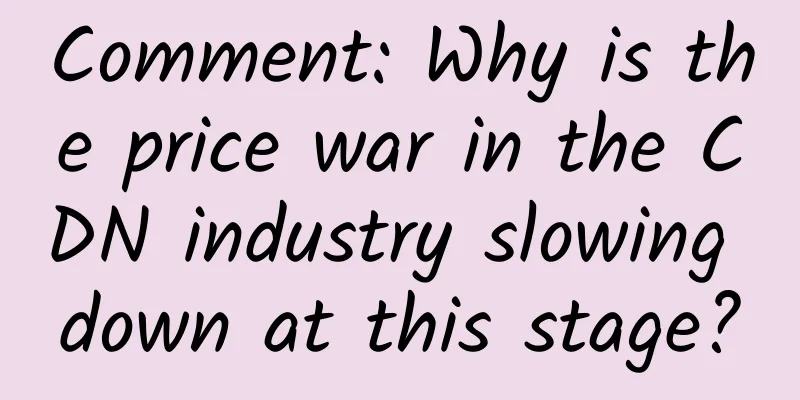Comment: Why is the price war in the CDN industry slowing down at this stage?

|
In the past two years, cloud computing companies have rushed into the CDN industry. The stable competition pattern in the industry has been broken, which is directly reflected in the price. The price decline rate in normal years is about -6%, and in 2016 and 2017, the price decline rate was about -20% for two consecutive years. Since July 2017, there has been no substantial drop in the price of the CDN industry. The price reduction has changed from being measured in yuan to being measured in cents. As of now, the industry's prices have tended to be stable.
Why is the price war slowing down at this stage? 1. The marginal effect of price wars is weakening Price is a stepping stone, which is usually effective in the early stage of entering a market, when the market share is from 0% to 10%. Now the market share of the two cloud companies has obviously exceeded this number. One type of price-sensitive users have migrated over the past two years, and the potential market is shrinking. Another type of Internet companies that will not go to the cloud avoid exposing their core operating data from a competitive perspective. 2. Rigid marginal cost of operation All variable costs will be bandwidth costs. In the early stages of CDN operation, when the scale is relatively small, cloud companies can take advantage of the overall large-scale advantages of cloud computing and have the advantage of reducing marginal costs. However, as the proportion of CDN business in cloud computing increases, the rigid costs of CDN are all bandwidth costs, which cannot be further compressed. The cost of traffic will increase linearly with the expansion of CDN scale, and the price war will directly lead to increased losses. At the same time, recent industry media reports have said that the Ministry of Industry and Information Technology will subsequently regulate companies that privately build transmission networks, which may lead to further increases in traffic costs. 3. Price + Service is the Ultimate Model From price competition to quality competition, service is an inevitable process. Market share is not determined by a single price factor, but is also affected by multiple factors such as product technology and service capabilities. As a B2B business, customers will not only choose the service with the lowest price; if you only adopt a low-price strategy without optimizing and improving products and services, then when the subsidy ends, customers will also be lost; In summary, in 2018, the CDN market competition stage will shift from price competition to service quality competition, and the price reduction will return to a reasonable range in the market. |
>>: What IoT strategies do global operators have?
Recommend
When 5G meets edge cloud, it is the fundamental reason why 5G changes the world
On June 6, 2019, a very auspicious day, the Minis...
GSMA Liu Hong: Who will build the 5G private network? Let the operators do it
[[383535]] 5G has the characteristics of high spe...
How the Network Supports Zero Trust
[[354213]] Building a zero-trust architecture typ...
Croatia officially issues 5G license
Croatian regulator HAKOM has allocated radio spec...
[11.11]80VPS: 50% off all VPS, special VPS annual payment starting from 199 yuan, multiple data centers in Hong Kong/US/Japan/Korea, etc.
80VPS also launched a promotion during the Double...
Wu Hequan: IPv6+ is an important tool for the third phase of large-scale deployment of IPv6
[[423701]] The large-scale deployment of IPv6 in ...
80VPS: VPS hosting starts at 199 yuan per year, with options for Los Angeles/Hong Kong CN2/Japan CN2/Korea BGP, etc.
We have shared the information of the cluster ser...
What to do if the Wi-Fi signal at home is not good? Here are 4 tips
Everyone needs Wi-Fi at home, but for various rea...
Active-active data centers are key to high-availability application resiliency
Enterprises that rely on high-availability applic...
What is SD-Branch? Why do you need it?
[51CTO.com Quick Translation] The deployed SD-WAN...
Can Huawei reshape the Internet?
[[320457]] This article is reproduced from Leipho...
BandwagonHost: $37.3/year KVM-1GB/20GB/1TB/Fremont Data Center
In January this year, BandwagonHost released a pa...
The changing world of ICO: What are the prospects for blockchain and virtual currency?
There have been many major events recently, rangi...
HTTP also has long and short connections? HTTP long connection vs. short connection
You must have heard about the so-called long conn...
Demand is holding back technology. WiFi6 is not yet popular. 6E is coming.
As 5G technology develops rapidly, Wi-Fi technolo...









